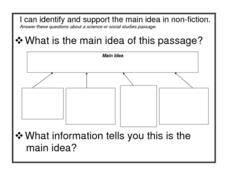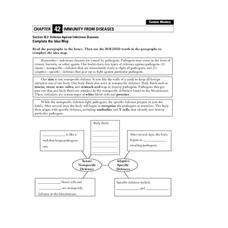Raymond C. Jones
Story Mapping History Frame
Map out the conflicts throughout history with a graphic organizer. It includes a section for kids to list the participants in an event, the problems or goals, and the theme or lesson learned.
Curated OER
Rocks and Minerals
Take young geologists on an exploration of the collection of rocks and minerals that we call Earth with an upper-elementary science lesson. Through a series of class discussion and hands-on investigations, students learn about the three...
Curated OER
Importance of the Ear
In this biology worksheet, students identify six important reasons of the ears in humans. They complete a graphic organizer filling in each of 6 circles with one reason of importance.
Curated OER
Rocks and Minerals
In this rocks and minerals worksheet, students complete a graphic organizer. They define rocks and minerals, they name the properties of minerals, they give examples of minerals and they name and describe 3 types of rocks.
Curated OER
Predators and Prey
In this predators and prey worksheet, learners complete a graphic organizer to show the relationship between the number of predators and prey as the predators increase or decrease. Students explain the results, why they occur and they...
Curated OER
Physical Agents for Microbial Control
In this biology worksheet, learners take part in an examination of the graphic organizer to determine the different types of environments and how they effect the survival of microbes.
Curated OER
VSEPR Theory: Valence Shell Electron Pair Repulsion Theory
In this atoms worksheet, students complete a graphic organizer by filling in the number of atoms, number of electron pairs, number of long pairs, bond angle, and molecular shape.
Curated OER
Properties
In this properties worksheet, students classify each of the properties given as either extensive or intensive and as either physical or chemical. This worksheet has 1 graphic organizer and 8 fill in the blank questions.
Curated OER
Ions and Subatomic Particles
For this ions worksheet, students complete a graphic organizer by filling in the number of protons and electrons plus the charge of the given ion.
Curated OER
Ways to Recycle
In this recycling activity worksheet, students identify 3 ways that they could personally conserve or recycle. Students record their ideas in the graphic organizer.
Curated OER
Newton's Laws
In this motion worksheet, students read about the 3 laws of motion and then complete a graphic organizer describing the laws and giving an example for each one.
Polk Bros Foundation
I Can Identify and Support the Main Idea in Non-Ficiton
Analyze a historical or scientific informational text by determining the main idea and supporting details. This graphic organizer allows pupils to write down the main idea and four details.
Curated OER
Swimming With the Crabs
In this expository writing activity, students read an article about crabs and a graphic organizer with crab facts. Students fill in a graphic organizer, including their specific topic about crabs and details to support their topic.
Curated OER
Swimming With the Crabs!
In this environmental science worksheet, students complete a graphic organizer (Frayer model) on blue crabs. They write an article using the given facts.
Curated OER
Flow of Energy Through An Ecosystem
In this flow of energy in an ecosystem, students complete a graphic organizer and show the flow of energy from the sun to producers, primary consumers, secondary consumers, tertiary consumers and then decomposers. Students define each of...
Curated OER
States of Matter
In this states of matter worksheet, students will brainstorm and write down facts about solids, liquids, and gases in a graphic organizer.
Curated OER
What Are Reptiles, Amphibians, And Fish?
In this animal classification worksheet, students will compare and contrast the characteristics of reptiles, amphibians, and fish. This worksheet is a graphic organizer.
Curated OER
Traits
In this traits worksheet, students will complete a graphic organizer by filling in the definition and an example of inherited, learned, acquired, and manipulated traits.
Curated OER
Movements of Earth and the Moon
In this Earth and moon worksheet, students will read about how the Earth rotates on its axis and how the moon revolves around the Earth. Students will then write in the effect of these two movements. This worksheet is a graphic organizer.
Curated OER
Why Are Fossil Fuels Limited?
In this fossil fuels worksheet, students will determine why fossil fuels are a limited resource and brainstorm possible solutions. This worksheet is a graphic organizer.
Curated OER
How Can Renewable Energy Be Used?
In this renewable energy worksheet, students will write in details about the 4 types of renewable energy sources: solar, wind, moving water, and nuclear energy. This worksheet is a graphic organizer.
Curated OER
How Does the Sun Seem To Move?
In this sun instructional activity, students will fill in the blank of 3 statements about observing the movement of the sun. Then students will fill in the blank of a conclusion they develop from the facts. This instructional activity is...
Curated OER
Plants
In this plants worksheet, students will review the basic steps of photosynthesis, how materials are transported through a plant, and the process of plant reproduction. This worksheet is a graphic organizer.
Curated OER
Defense Against Infectious Diseases
In this infectious diseases learning exercise, students read about the two types of defenses the body has against pathogens: innate (nonspecific) and adaptive (specific). Students then complete a graphic organizer by filling in 11 blanks.

























